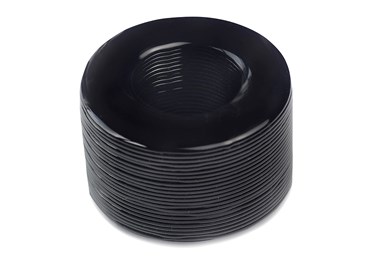ChromaMotive D65 Parts Perform Well in Range of Extreme Temperatures
Formnext 2023: The Shore D thermoset polyurethane is well suited for applications that have varying temperature requirements, in a range extreme cold to elevated temperatures from -30 up to 120°C.
With ChromaMotive D65, manufacturers can have the benefits of 3D printing with mechanical performance properties that are comparable to injection-molded TPU, HDPE and PP. Photo Credit: Chromatic 3D Materials
Chromatic 3D Materials’ ChromaMotive D65 is a a rigid Shore D thermoset polyurethane designed for reactive extrusion additive manufacturing (AM) with the company’s RX-AM printing platform. This material performs well in a range of extreme cold to elevated temperatures from -30 up to 120°C. It is compatible with Chromatic’s RX-Flow printers, which are suitable for development work and low- to medium-volume industrial production.
With very good low-temperature impact strength, ChromaMotive D65 is well suited for manufacturing winter sports gear like ski boots, snowshoes and snowmobile parts. It is also designed for other applications that have varying temperature requirements, such as parts for the aerospace, automotive and agricultural industries.
Chromatic’s RX-AM materials and technology platform is based on reactive extrusion additive manufacturing, a type of deposition 3D printing that uses chemical reactions. With ChromaMotive D65, manufacturers can have the benefits of 3D printing with mechanical performance properties that are comparable to injection-molded TPU, HDPE and PP. The material resists high impact, hydrolysis and abrasion, and withstands repeated friction, wear and tear. Moreover, its isotropic tensile properties ensure that 3D printed parts are uniformly resilient.
“With ChromaMotive D65, manufacturers that are producing rigid plastic components can take advantage of RX-AM’s fast print speeds and the ability to print on textiles, plastics and metals,” says Cora Leibig, Chromatic 3D Materials founder and CEO. “Now it’s possible to 3D print rigid parts at industrial volumes for everything from winter recreational equipment to aircraft interiors.”
- Learn about Chromatic’s RX-Flow 2500 3D printing system which features a compact workspace. The printer has a more compact workspace, while maintaining the cost efficiency, speed and quality output of the larger RX-Flow models.
- Read about Chromatic 3D Materials’ polyurethanes meeting flammability requirements for the aerospace industry. NIAR testing shows that multiple polyurethanes 3D printed by Chromatic are compliant with U.S. standards for use in aircraft interiors.
- Check out this article on Chromatic 3D Materials launching a rapid custom manufacturing service for common rubber parts. The service includes standard industrial shapes, including gaskets, seals, cylinders and grommets in customizable, nonstandard dimensions up to 16" in diameter.
Related Content
-
New Electric Dirt Bike Is Designed for Molding, but Produced Through 3D Printing (Includes Video)
Cobra Moto’s new all-electric youth motocross bike could not wait for mold tooling. Parts have been designed so they can be molded eventually, but to get the bike to market, the production method now is additive manufacturing.
-
3D Printed Ductile Spikes for Better Sound Quality: The Cool Parts Show Bonus
Work on 3D printing flexible metal bellows has led to other applications, including the development of ductile spikes that sit between a speaker and the surface below to help limit vibration and isolate the audio equipment.
-
3DEO Wins Design Excellence Awards
3DEO was recognized for outstanding applications of powder metallurgy.













